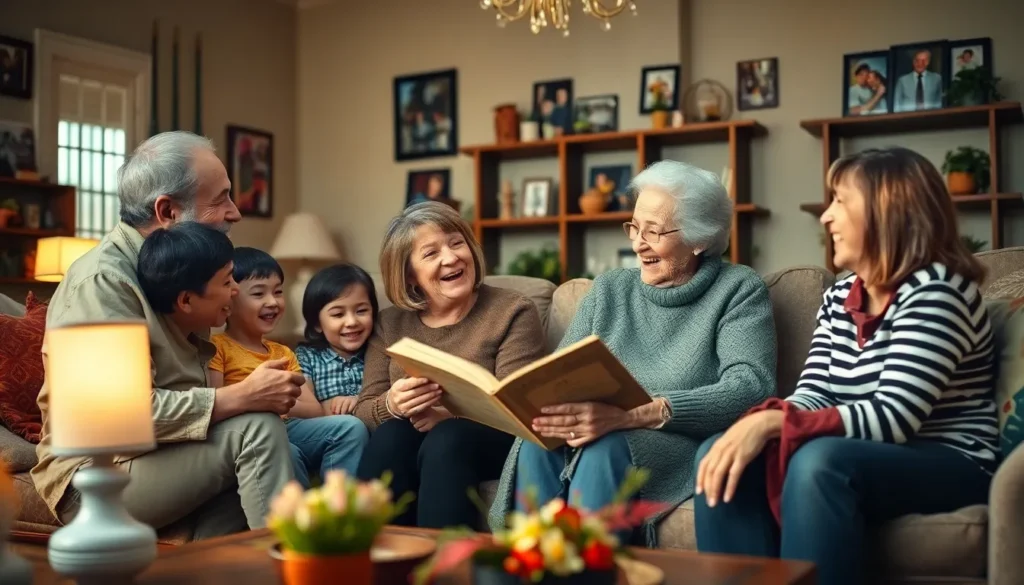Family tradition stories are the delightful threads that weave generations together, often filled with laughter, lessons, and a sprinkle of chaos. From Grandma’s infamous Thanksgiving turkey mishap to Dad’s legendary dance moves at family reunions, these tales not only entertain but also keep the spirit of family alive. They remind everyone that no matter how far apart they may roam, there’s always a piece of home waiting to be shared.
As the family gathers around the dinner table or during holiday celebrations, these stories become the glue that holds them together. They spark conversations, evoke nostalgia, and sometimes leave everyone in stitches. So, whether it’s sharing a cherished memory or discovering a new family legend, diving into these narratives can turn any gathering into a memorable event. After all, who wouldn’t want to hear about Uncle Bob’s epic fishing fail?
Table of Contents
ToggleUnderstanding Family Tradition Stories
Family tradition stories enhance connections between generations. These narratives capture shared memories, offering insight into family dynamics.
Definition and Significance
Family tradition stories signify the collective identity of a group. They often reflect values and lessons passed down through generations. Examples like Grandma’s Thanksgiving mishap and Dad’s dance moves create a sense of belonging. Not only do they entertain, but they also foster nostalgia during gatherings. Cherished memories and new family legends emerge through storytelling, strengthening bonds among relatives. These tales serve as a living record of family history, intertwining laughter and lessons.
Cultural Impacts
Cultural impacts of family tradition stories shape collective experiences. These narratives transmit cultural values and practices within families. Variations exist across different cultures, showcasing unique customs and beliefs. Sharing stories at gatherings fosters unity and encourages younger members to embrace their heritage. Additionally, family tradition stories promote resilience, as they often recount overcoming challenges. They enhance cultural pride, revealing the rich tapestry of a family’s past. Engaging with these tales deepens connections and nurtures understanding of cultural identities.
Types of Family Tradition Stories

Family tradition stories come in various forms, each conveying unique aspects of heritage and connection. These narratives can be broadly categorized into oral narratives and written accounts.
Oral Narratives
Oral narratives carry the voices and emotions of family members through spoken word. These stories often emerge during family gatherings, where laughter and anecdotes animate the memories. They provide a personal touch, allowing tellers to convey feelings behind every event. Grandparents frequently share their tales of youth, which often evoke nostalgia and laughter among listeners. Such narratives help younger generations connect with their roots, preserving history and values through generations. Sharing stories orally fosters a strong bond among family members, allowing them to engage actively with their heritage.
Written Accounts
Written accounts serve as tangible records of family tradition stories, capturing intricate details and lessons. Many families compile these narratives in journals or scrapbooks, creating cherished keepsakes that can be passed down. These texts often include significant dates, photographs, and stories that mark important family milestones. By documenting history, families ensure that future generations gain insight into cultural heritage. Written narratives can also provide a sense of permanence that oral stories may not possess. Through careful documentation, families create a legacy that reinforces their identity and values for years to come.
Gathering Family Tradition Stories
Collecting family tradition stories takes effort and creativity. Engaging relatives fosters connections and enriches storytelling experiences.
Interviews with Family Members
Conducting interviews offers personal insights into family histories. Start by preparing open-ended questions that elicit vivid memories. Encourage relatives to share their stories in their own words. Listening actively can uncover unexpected gems, such as Grandma’s secret recipe mishaps or Uncle Joe’s adventurous trips. Recording these conversations preserves emotions and laughter, creating an authentic feel. Such exchanges not only strengthen family bonds but also ensure that unique narratives continue to thrive for future generations.
Documenting Stories
Documenting stories solidifies family traditions for posterity. Choose formats that suit the family’s preference, whether that’s written journals, digital recordings, or scrapbooks. A dedicated family historian can maintain a shared document where everyone contributes their tales over time. Include photos and artifacts to enhance the narrative and provide context. This tangible collection keeps traditions alive, allowing future generations to experience their heritage first-hand. Keeping these accounts accessible ensures families remember and celebrate their unique legacies.
Benefits of Sharing Family Tradition Stories
Sharing family tradition stories brings numerous benefits that enhance family relationships and cultural awareness. These tales create connections between generations, fostering empathy and understanding.
Strengthening Family Bonds
Family tradition stories strengthen bonds among relatives. Relatives gather around and share memories, igniting laughter and creating shared experiences. Children gain a sense of belonging when they hear about family heroes and adventures. The storytelling process invites engagement, allowing each family member to contribute their perspective. Telling stories during gatherings encourages communication and fosters closeness, helping families navigate challenges together. As stories pass down through generations, they weave a rich tapestry of connections that keeps families united.
Preserving Cultural Heritage
Preservation of cultural heritage becomes significant through storytelling. Families convey important values and traditions, ensuring future generations stay connected to their roots. Oral stories reflect unique histories, while written accounts provide tangible legacies. These narratives carry lessons from the past, guiding younger members in their lives. A deeper understanding of cultural identity develops when families embrace their histories. By sharing these stories, families celebrate their uniqueness and enrich their cultural landscape, empowering them to embrace diverse backgrounds.
Family tradition stories are more than just entertaining anecdotes; they’re vital threads that weave generations together. Through shared laughter and lessons, these narratives create a sense of belonging and preserve cultural heritage. As families gather to share these memories, they not only celebrate their unique identities but also strengthen bonds that transcend time.
Engaging in the storytelling process fosters communication and closeness among relatives, inviting every member to contribute their voice. By documenting these tales, families ensure that their legacies endure, enriching the lives of future generations. Ultimately, family tradition stories serve as a powerful reminder of the importance of connection, identity, and the shared experiences that shape who they are.

